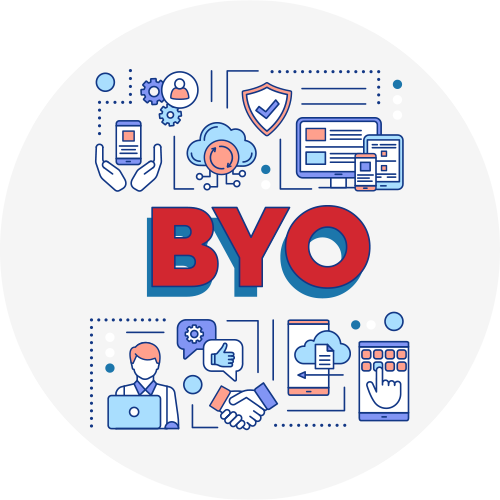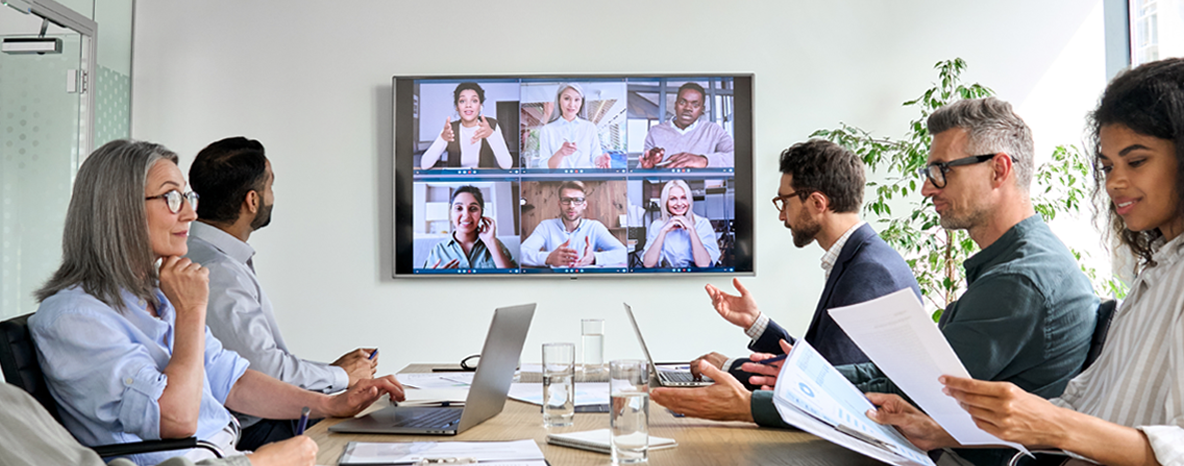
January 24, 2024
BYO-Solutions In The Meeting Room
If anything, the past few years have shown us the importance of being prepared for the unexpected. Having meeting rooms that can cater to any device and platform helps ensure that IT managers are never caught unawares.
Today, meeting rooms need to be flexible and adaptable to cater to a variety of presenters, meeting purposes, lengths, and formats. The available technology must support a multitude of needs without hindering successful sales pitches, briefings, brainstorms, or other collaborative meetings, whether offline or online.
Modern meeting rooms include laptops (of various models and brands), personal devices such as smartphones and tablets, projectors, wireless sharing devices, microphones, and webcams. The audiovisual (AV) system must seamlessly accommodate any equipment being used, attendees, and meeting type.
BYO Concepts in Meeting Spaces
The challenge of meeting room compatibility can be addressed by incorporating BYO concepts in the meeting room. In recent years, the IT/AV world has witnessed the rise of several acronyms starting with BYO.
Let's take a look at the three most popular ones:
BYOD – Bring Your Own Device: This term is broadly used in IT to describe workplace policies that allow employees to use their privately-owned devices to access company applications and privileged information on private servers instead of using company-issued devices.
BYOD in the meeting room refers to the ability to bring a personal device into a meeting space instead of relying on a hard codec or a dedicated PC installed in the room. Solutions like MAX CONNECT offer affordable meeting room solutions that support BYOD.
BYOM – Bring Your Own Meeting: BYOM describes a meeting space that is designed to be platform-agnostic, allowing users to utilize their preferred web- or cloud-based video conferencing applications such as Microsoft Teams, Zoom, Google Meet, Cisco Webex, and others.
BYOA – Bring Your Own Applications: BYOA refers to company policies that enable employees to use their preferred productivity and collaboration apps instead of standard software offered by their employers. In a meeting space, BYOA apps would be used on employees' personal or private devices and shared wired or wirelessly via projectors, displays, or interactive whiteboards.


The Meeting Room Compatibility Challenge
Meeting rooms today need to accommodate a wide range of devices, meeting formats, and attendee preferences. The AV technology must seamlessly support these diverse requirements without impeding the success of meetings, whether they are in-person or virtual.
Devices commonly found in modern meeting rooms include laptops (of various models and brands), smartphones, tablets, projectors, wireless sharing devices, microphones, and webcams.
The AV system must be flexible enough to work seamlessly regardless of the equipment used, attendees present, and meeting type.
Advantages of a BYO Solution in the Meeting Room
Time Saved
BYO principles can increase employee productivity by allowing them to use familiar devices and applications, saving time otherwise spent on IT onboarding and learning company-issued tools.
This approach also reduces the number of IT support tickets, which is particularly crucial in meeting spaces where time is limited and should not be wasted on IT issues.
Employee Satisfaction
Providing the freedom to use preferred devices, video conferencing tools, and collaboration apps can boost employee morale and job satisfaction. BYO policies are often used as a recruitment strategy to attract a young, tech-savvy workforce.
Innovation
In the knowledge-based economy, highly skilled employees are a company's most valuable assets. BYO strategies that promote employees' freedom and flexibility to work and collaborate in their own preferred ways create an environment for knowledge sharing, idea generation, productivity, efficiency, and innovation.


Why should more meeting rooms be video-enabled?
Remote meetings are now increasingly common in office environments. Many companies now have a global presence, with teams spread across multiple locations. Additionally, organizations often hire external agencies and freelancers, making remote collaboration essential. The COVID-19 pandemic in 2020 accelerated the need for remote meetings as employees went into quarantine.
This shift in working norms has placed new demands on enterprises' physical and IT infrastructure. Personal workstations are equipped with company-issued audio endpoints such as headsets, microphones, and webcams, enabling employees to collaborate remotely from their desks.
The rising number of remote meetings has also increased demand for meeting room availability, prompting enterprises to repurpose office spaces into meeting rooms to accommodate this surge.
While laptops can facilitate video meetings, the built-in audio and video capabilities often offer subpar quality. In meetings with a mix of in-person and remote attendees, relying solely on laptops becomes insufficient for clear and effective communication. Dedicated hardware designed for online meetings and video conferencing is essential in such scenarios.
What does a BYOD-friendly, video-enabled meeting space look like?
To enable meeting room users to have the freedom to use their devices and preferred applications, meeting rooms must be highly compatible with various devices. IT teams should ensure that the AV system provides a seamless experience, allowing users to focus on collaboration rather than troubleshooting technical issues.
There are several options to make meeting spaces compatible with users' devices and desired applications, depending on factors such as room size, new installations versus retrofits, company policies, budgetary constraints, and more.
Wireless Solutions
Wireless solutions offer flexibility, allowing users to share their laptop, tablet, or smartphone screen without the need for cables. Solutions like Airtame, Barco ClickShare, wePresent, and Mersive Solstice
consist of a receiver connected to a display or projector.
Users can share their screen using a transmitter or dedicated applications, often with additional collaboration features like annotation tools. Furthermore, solutions like Biamp’s MAX CONNECT makes it easy for users to join a meeting, to sharing content, to adding remote participants, and even controlling room AV.
Wireless solutions also enhance mobility within the meeting room, as presenters are not tethered to specific spots. They can reduce support time by eliminating the need for special adapters for wired connections.
Wired Solutions
Wired solutions provide a stable connection by connecting personal devices to displays or AV systems using HDMI or USB connections. This approach ensures connectivity regardless of whether devices are connected
to the network.
A simple wired solution involves connecting a personal device to a display using an HDMI cable, while a more advanced setup might involve connecting to a hub. Hubs offer the advantage of connecting multiple peripherals with a single cable, simplifying the setup process.
Additionally, a control system like our Impera Uniform or our range of Touch Panels and controller can be installed to connect and operate different AV devices, supporting both wired and wireless screen sharing, presentations, and video conferencing.
356819c45e1641299275a92801147341.png?sfvrsn=c27e58ac_0)

Ensure Easy and Fast Connections in Meetings
Regardless of the meeting type, it is crucial for users to connect quickly and easily to get their meetings started. Once an online meeting begins, stable audio and video connections are equally important to ensure everyone in the room can be clearly seen and heard.
Collaboration meetings require high compatibility with any devices presenters may bring to the room.
INSPIRING CASE STORIES
LET'S CONNECT
Fill out this form and a Biamp expert will reach out to you via phone or email. In some regions we may share your contact details and inquiry with one of our qualified third-party sales partners to follow up directly to ensure better local service. For more information please see our Privacy Policy.




